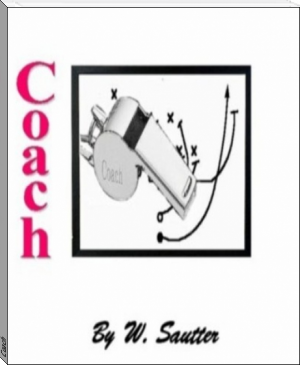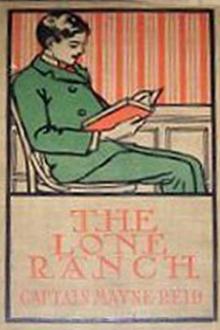The Young Voyageurs: Boy Hunters in the North, Mayne Reid [some good books to read .txt] 📗

- Author: Mayne Reid
Book online «The Young Voyageurs: Boy Hunters in the North, Mayne Reid [some good books to read .txt] 📗». Author Mayne Reid
With these ideas Lucien had grasped his gun, and was raising himself to creep a little nearer, when his eye was arrested by the motions of another creature coming along the top of the wreath. This last was a snow-white animal, with long, shaggy fur, sharp-pointed snout, erect ears, and bushy tail. Its aspect was fox-like, and its movements and attitudes had all that semblance of cunning and caution so characteristic of these animals. Well might it, for it was a fox—the beautiful white fox of the Arctic regions.
It is commonly supposed that there are but two or three kinds of foxes in America; and that these are only varieties of the European species.
This is an erroneous idea, as there are nearly a dozen varieties existing in North America, although they may be referred to a less number of species. There is the Arctic fox, which is confined to the cold Northern regions, and which in winter is white.
The “sooty fox” is a variety of the “Arctic,” distinguished from it only by its colour, which is of a uniform blackish brown.
The “American fox” (Vulpes fulvus), or, as it is commonly called, the “red fox,” has been long supposed to be the same as the European red fox. This is erroneous. They differ in many points; and, what is somewhat curious, these points of difference are similar to those that exist between the European and American wolves, as already given.
The “cross fox” is supposed by the Indians and some naturalists to be only a variety of the last. It derives its name from its having two dark stripes crossing each other upon the shoulders. Its fur from this circumstance, and perhaps because the animal is scarce, is more prized than that of the red variety. When a single skin of the latter is worth only fifteen shillings, one of the cross fox will bring as much as five guineas.
Another variety of the red fox, and a much more rare one, is the “black,” or “silver” fox. The skins of these command six times the price of any other furs found in America, with the exception of the sea-otter. The animal itself is so rare that only a few fall into the hands of the Hudson’s Bay Company in a season; and Mr Nicholay, the celebrated London furrier, asserts that a single skin will fetch from ten to forty guineas, according to quality. A remarkable cloak, or pelisse, belonging to the Emperor of Russia, and made out of the skins of silver-foxes, was exhibited in the Great London Exposition of 1851. It was made entirely from the neck-part of the skins—the only part of the silver-fox which is pure black. This cloak was valued at 3400 pounds; though Mr Nicholay considers this an exaggerated estimate, and states its true value to be not over 1000 pounds. George the Fourth had a lining of black fox-skins worth 1000 pounds.
The “grey fox” is a more southern species than any already described. Its proper home is the temperate zone covered by the United States; although it extends its range into the southern parts of Canada. In the United States it is the most common kind, although in that district there is also a “red fox,” different from the Vulpes fulvus already noticed; and which, no doubt, is the red fox of Europe, introduced by the early colonists of America.
Still another species, the smallest and perhaps the most interesting of any, is the “kit fox.” This little creature is an inhabitant of the prairies, where it makes its burrows far from any wood. It is extremely shy, and the swiftest animal in the prairie country—outrunning even the antelope!
When Lucien saw the fox he thought no more of the ermine, but drew back and crouched down, in hopes he might get a shot at the larger animal. He knew well that the flesh of the Arctic fox is highly esteemed as food, particularly by persons situated as he and his companions were, and he hoped to be able to add it to their larder.
When first seen it was coming towards him, though not in a direct line. It was engaged in hunting, and, with its nose to the snow, was running in zig-zag lines, “quartering” the ground like a pointer dog. Presently it struck the trail of the ermine, and with a yelp of satisfaction followed it. This of course brought it close past where Lucien was; but, notwithstanding his eagerness to fire, it moved so rapidly along the trail that he was unable to take sight upon it. It did not halt for a moment; and, as Lucien’s gun was a rifle, he knew that a flying shot would be an uncertain one. In the belief, therefore, that the fox would stop soon—at all events when it came up with the ermine—he restrained himself from firing, and waited.
It ran on, still keeping the track of the ermine. The latter, hitherto busy with his own prey, did not see the fox until it was itself seen, when, dropping the half-eaten mouse, it reared up on its hindquarters like a squirrel or a monkey, at the same time spitting as spitefully as any other weasel could have done. In a moment, however, it changed its tactics—for the open jaws of the fox were within a few paces of it—and after making a short quick run along the surface, it threw up its hindquarters, and plunged head-foremost into the snow! The fox sprang forward, and flinging his brush high in air, shot after like an arrow!
Both had now disappeared from Lucien’s sight. For a moment the surface of the snow was disturbed above the spot where they had gone down, but the next moment all was still, and no evidence existed that a living creature had been there, except the tracks, and the break the two creatures had made in going down. Lucien ran forward until he was within a few yards of the place, and stood watching the hole, with his rifle ready—thinking that the fox, at least, would soon come up again.
He had waited for nearly five minutes, looking steadily at this point, when his eye was attracted by a movement under the snow, at a considerable distance, quite fifty paces, from where he stood. The frozen crust was seen to upheave; and, the next moment, the head of the fox, and afterwards his whole body, appeared above the surface. Lucien saw that the ermine lay transversely between his jaws, and was quite dead! He was about to fire, but the fox, suddenly perceiving him, shot off like an arrow, carrying his prey along with him. He was soon out of reach, and Lucien, seeing that he had lost his chance, was about to return to the fire, when, all at once, the fox was observed to stop, turn suddenly in his tracks, and run off in a new direction! Lucien looked beyond to ascertain the cause of this strange manoeuvre. That was soon ascertained. Coming down from among the rocks was a large animal—five times the fox’s size—but in other respects not unlike him. It was also of a snow-white colour, with long hair, bushy tail, and short erect ears, but its aspect was not to be mistaken. It was the great white wolf.
When Lucien first saw this new-comer, the latter had just espied the fox, and was about stretching out into a gallop towards him. The fox, watching backwards as he ran, had not seen the wolf, until the latter was within a few springs of him; and now when he had turned, and both were in full chase, there was not over twenty yards between them. The direction in which they ran would bring them near to Lucien; and so they came, and passed him—neither of them seeming to heed his presence. They had not got many yards farther, before Lucien perceived that the wolf was fast closing on the fox, and would soon capture him. Believing he would then stop, so as to offer him a fairer chance for a shot, Lucien followed. The wolf, however, had noticed him coming after, and although the next moment he closed his great jaws upon the fox, he did not pause for a single instant, but, lifting the latter clear up from the ground, ran on without the slightest apparent diminution of speed!
Reynard was seen to struggle and kick, while he squeaked like a shot puppy; but his cries each moment grew feebler, and his struggles soon came to an end. The wolf held him transversely in his jaws—just as he himself but the moment before had carried the ermine.
Lucien saw there was no use in following them, as the wolf ran on with his prey. With some disappointment, therefore, he was about to return to the fire, where, to add to his mortification, he knew he would find his tea-leaves parched to a cinder. He lingered a moment, however, with his eyes still fixed upon the departing wolf that was just about to disappear over the crest of a ridge. The fox was still in his jaws, but no longer struggling. Reynard looked limber and dead, as his legs swung loosely on both sides of the wolf’s head. Lucien at that moment saw the latter suddenly stop in his career, and then drop down upon the surface of the snow as if dead! He fell with his victim in his jaws, and lay half doubled up, and quite still.
This strange action would have been a difficult thing for Lucien to explain, but, almost at the same instant in which he observed it, a puff of blue smoke shot up over the ridge, and quickly following was heard the sharp crack of a rifle. Then a head with its cap of raccoon skin appeared above the snow, and Lucien, recognising the face of Basil, ran forward to meet him.
Both soon stood over the body of the dead wolf, wondering at what they saw; but Basil, far more than Lucien—for the latter already knew the circumstances of that strange scene of death. First there was the great gaunt body of the wolf stretched along the snow, and quite dead. Crossways in his mouth was the fox, just as he had been carried off; and across the jaws of the latter, lay the long worm-like body of the ermine, still retaining between its teeth the half-devoured remains of the white-footed mouse! A very chain of destroyers! These creatures died as they had lived, preying one upon the other! Of all four the little mouse alone was an innocent victim. The other three, though morally guilty by the laws of man, yet were only acting in obedience to the laws of Nature and necessity. Man himself obeys a similar law, as Basil had just shown. Philosophise as we will, we cannot comprehend why it is so—why Nature requires the sacrifice of one of her creatures for the sustenance of another. But although we cannot understand the cause, we must not condemn the fact as it exists; nor must we suppose, as some do, that the destruction of God’s creatures for our necessities constitutes a crime. They who think so, and who, in consistency with their doctrines, confine themselves to what they term “vegetable” food, are at best but shallow reasoners. They have not studied Nature very closely, else would they know that every time they pluck up a parsnip, or draw their blade across the leaf of a lettuce,





Comments (0)